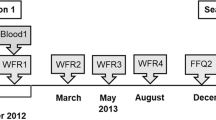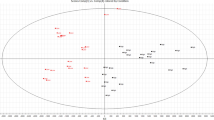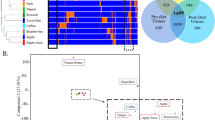Abstract
Objective:
Estimation of dietary intake of polyphenols is difficult, due to limited availability of food composition data and bias inherent to dietary assessment methods. The aim of the present study was to evaluate whether we could detect polyphenols and their metabolites in a spot urine sample in a free-living human population and whether it was related to those observed in 24-h urine samples, for potential use as a biomarkers of polyphenol intake.
Subjects:
Four 24-h urine samples and two spot urine samples were collected from 154 participants of the SU.VI.MAX cohort (a randomized primary-prevention trial evaluating the effect of daily antioxidant supplementation on chronic diseases) in two separate studies over, respectively, a 7- and 2-day periods. Thirteen polyphenols and metabolites (chlorogenic acid (CGA), caffeic acid (CA), m-coumaric acid (mCOU), gallic acid (GA), 4-O-methylgallic acid (MeGA), quercetin (Q), isorhamnetin (MeQ), kaempferol (K), hesperetin (HESP), naringenin (NAR), phloretin (PHLOR), enterolactone (ENL) and enterodiol (END) were measured using HPLC-ESI-MS-MS.
Results:
Correlations between the urinary excretion levels were observed. The most significant were explained by metabolic filiations (CGA/CA, CA/mCOU, GA/MeGA, Q/MeQ, NAR/PHLOR, ENL/END) or co-occurrence in a same food source (NAR/HESP). Concentrations in spot samples correlated with those in 24-h urine sample (P<0.02, except for CA and for MeQ). Intra-individual variations were smaller than inter-individual variations for all polyphenols (P<0.01) except for MeGA and for PHLOR.
Conclusion:
These results show that these polyphenols and metabolites are useful biomarkers for polyphenol intake.
This is a preview of subscription content, access via your institution
Access options
Subscribe to this journal
Receive 12 print issues and online access
$259.00 per year
only $21.58 per issue
Buy this article
- Purchase on Springer Link
- Instant access to full article PDF
Prices may be subject to local taxes which are calculated during checkout
Similar content being viewed by others
References
Adlercreutz H, Fotsis T, Bannwart C, Wähälä K, Mäkelä T, Brunow G et al. (1986). Determination of urinary lignans and phytoestrogens metabolites, potential antiestrogens and anticarcinogens, in urine of women on various habitual diets. J Steroid Biochem 25, 791–797.
Beer-Borst S, Hercberg S, Morabia A, Bernstein MS, Galan P, Galasso R et al. (2000). Dietary patterns in six European populations: results from EURALIM, a collaborative European data harmonization and information campaign. Eur J Clin Nutr 54, 253–262.
Belajova E, Suhaj M (2004). Determination of phenolic constituents in citrus juices: method of high performance liquid chromatography. Food Chemistry 86, 339–343.
Bingham SA (1991). Limitations of the various methods for collecting dietary intake data. Ann Nutr Metab 35, 117–127.
Bingham SA (2002). Biomarkers in nutritional epidemiology. Public Health Nutr 5, 821–827.
Block G (1982). A review of validations of dietary assessment methods. Am J Epidemiol 115, 492–505.
Borriello SP, Setchell KDR, Axelson M, Lawson AM (1985). Production and metabolism of lignans by the human fecal flora. J Appl Bacteriol 58, 37–43.
de Vries JH, Hollman PC, Meyboom S, Buysman MN, Zock PL, van Staveren WA et al. (1998). Plasma concentrations and urinary excretion of the antioxidant flavonols quercetin and kaempferol as biomarkers for dietary intake. Am J Clin Nutr 68, 60–65.
DuPont MS, Bennett RN, Mellon FA, Williamson G (2002). Polyphenols from alcoholic apple cider are absorbed, metabolized and excreted by humans. J Nutr 132, 172–175.
Gonthier MP, Verny MA, Besson C, Remesy C, Scalbert A (2003). Chlorogenic acid bioavailability largely depends on its metabolism by the gut microflora in rats. J Nutr 133, 1853–1859.
Hercberg S, Galan P, Preziosi P, Bertrais S, Mennen L, Malvy D et al. (2004). The SU.VI.MAX Study: a randomized, placebo-controlled trial of the health effects of antioxidant vitamins and minerals. Arch Intern Med 164, 2335–2342.
Hertog MGL, Feskens EJM, Hollman PCH, Katan MB, Kromhout D (1993). Dietary antioxidant flavonoids and risk of coronary heart disease: the Zutphen Elderly Study. Lancet 342, 1007–1011.
Hirvonen T, Pietinen P, Virtanen M, Ovaskainen ML, Hakkinen S, Albanes D et al. (2001). Intake of flavonols and flavones and risk of coronary heart disease in male smokers. Epidemiology 12, 62–67.
Hodgson JM, Chan SY, Puddey IB, Devine A, Wattanapenpaiboon N, Wahlqvist ML et al. (2004). Phenolic acid metabolites as biomarkers for tea- and coffee-derived polyphenol exposure in human subjects. Br J Nutr 91, 301–306.
Hodgson JM, Morton LW, Puddey IB, Beilin LJ, Croft KD (2000). Gallic acid metabolites are markers of black tea intake in humans. J Agric Food Chem 48, 2276–2280.
Horn-Ross PL, Barnes S, Kirk M, Coward L, Parsonnet J, Hiatt RA (1997). Urinary phytoestrogen levels in young women from a multiethnic population. Cancer Epidemiol Biomarkers Prev 6, 339–345.
Ito H, Gonthier M-P, Manach C, Morand C, Mennen L, Rémésy C et al. (2005). Polyphenol levels in human urine after intake of six different polyphenol-rich beverages. Br J Nutr 94, 500–509.
Kaaks RJ (1997). Biochemical markers as additional measurements in studies of the accuracy of dietary questionnaire measurements: conceptual issues. Am J Clin Nutr 65, 1232S–1239S.
Kirkman LM, Lampe JW, Campbell DR, Martini MC, Slavin JL (1995). Urinary lignan and isoflavonoid excretion in men and women consuming vegetable and soy diets. Nutr Cancer – Int J 24, 1–12.
Knekt P, Jarvinen R, Reunanen A, Maatela J (1996). Flavonoid intake and coronary mortality in Finland: a cohort study. Br Med J 312, 478–481.
Krogholm KS, Haraldsdottir J, Knuthsen P, Rasmussen SE (2004). Urinary total flavonoid excretion but not 4-pyridoxic acid or potassium can be used as a biomarker for the intake of fruits and vegetables. J Nutr 134, 445–451.
Lampe JW, Gustafson DR, Hutchins AM, Martini MC, Li S, Wähälä K et al. (1999). Urinary isoflavonoid and lignan excretion on a Western diet: relation to soy, vegetable, and fruit intake. Cancer Epidemiol Biomarkers Prev 8, 699–707.
Manach C, Scalbert A, Morand C, Rémésy C, Jimenez L (2004). Polyphenols – food sources and bioavailability. Am J Clin Nutr 79, 727–747.
Manach C, Williamson G, Morand C, Scalbert A, Remesy C (2005). Bioavailability and bioefficacy of polyphenols in humans. I. Review of 97 bioavailability studies. Am J Clin Nutr 81, 230S–242S.
Maskarinec G, Singh S, Meng L, Franke AA (1998). Dietary soy intake and urinary isoflavone excretion among women from a multiethnic population. Cancer Epidemiol Biomarkers Prev 7, 613–619.
Mennen L, Sapinho D, Ito H, Galan P, Hercberg S, Scalbert A (2006). Urinary flavonoids and phenolic acids as biomarkers of intake for polyphenol-rich foods. British Journal of Nutrition 96, 191–198.
Nielsen SE, Freese R, Kleemola P, Mutanen M (2002). Flavonoids in human urine as biomarkers for intake of fruits and vegetables. Cancer Epidemiol Biomarkers Prev 11, 459–466.
Noroozi M, Burns J, Crozier A, Kelly IE, Lean ME (2000). Prediction of dietary flavonol consumption from fasting plasma concentration or urinary excretion. Eur J Clin Nutr 54, 143–149.
Scalbert A, Manach C, Morand C, Rémésy C, Jiménez L (2005). Dietary polyphenols and the prevention of diseases. Crit Rev Food Sci Nutr 45, 287–306.
Scalbert A, Williamson G (2000). Dietary intake and bioavailability of polyphenols. J Nutr 130, 2073S–2085S.
Acknowledgements
This project received a grant from the French Ministry of Research (N° 02 P 0681). Special thanks to Unilever Bestfoods France (UBF), the ‘Centre d’Information Scientifique Thé & Santé de Lipton', UBF and the Agence Pour la Recherche et l'Information en Fruits et Légumes frais (APRIFEL) for financial support. We thank the Dunn Human Nutrition Unit (UK) who provided us the PABA tablets for the study and Sandrine Bertrais for revising the article, and also Ministry of Agriculture, Unilever-Bestfoods France, APRIFEL.
Author information
Authors and Affiliations
Corresponding author
Additional information
Guarantor:A Scalbert.
Contributors: LIM designed the study, participated in the statistical analyses and wrote the paper, DS performed the data handling and the statistical analyses, HI developed the analytical methods and performed the polyphenol analyses, PG and SH designed and supervised the SU.VI.MAX study and AS participated in the study design and initiated the development of the analytical methods. All contributors participated in the writing of the paper.
Rights and permissions
About this article
Cite this article
Mennen, L., Sapinho, D., Ito, H. et al. Urinary excretion of 13 dietary flavonoids and phenolic acids in free-living healthy subjects – variability and possible use as biomarkers of polyphenol intake. Eur J Clin Nutr 62, 519–525 (2008). https://doi.org/10.1038/sj.ejcn.1602744
Received:
Revised:
Accepted:
Published:
Issue Date:
DOI: https://doi.org/10.1038/sj.ejcn.1602744
Keywords
This article is cited by
-
The gut microbiome drives inter- and intra-individual differences in metabolism of bioactive small molecules
Scientific Reports (2020)
-
Dietary Behavior and Urinary Gallic Acid Concentrations in Older Minority Residents of East Harlem, New York City
Journal of Racial and Ethnic Health Disparities (2020)
-
Correlations between urinary concentrations and dietary intakes of flavonols in the European Prospective Investigation into Cancer and Nutrition (EPIC) study
European Journal of Nutrition (2020)
-
Evaluation at scale of microbiome-derived metabolites as biomarker of flavan-3-ol intake in epidemiological studies
Scientific Reports (2018)
-
Urinary excretions of 34 dietary polyphenols and their associations with lifestyle factors in the EPIC cohort study
Scientific Reports (2016)



